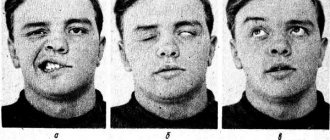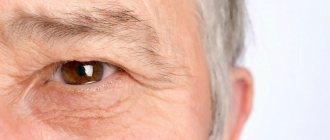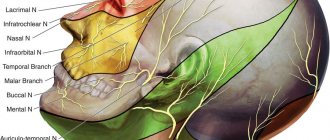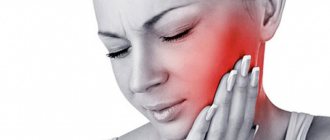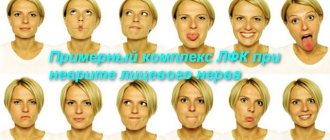The facial nerve performs an important function - it provides movement in the facial muscles. It is thanks to him that we can express emotions without words and make grimaces - scary or funny. The facial nerve also controls the stapedius muscle, which protects the ear from loud sounds, ensures the perception of taste by the anterior two-thirds of the tongue, and increases the secretion of saliva. With neuritis, these functions are disrupted.
Our expert in this field:
Lashch Natalia Yurievna
Neurologist of the highest category, candidate of medical sciences, associate professor. Laureate of the Moscow City Prize in the field of medicine.
Call the doctor Reviews about the doctor
Some facts about facial neuritis:
- Another name for the pathology is Bell's palsy. It is associated with the name of the Scottish anatomist Charles Bell, who first described the disease in 1821.
- The disease has different prevalence in different regions and occurs more often in the cold season.
- In the United States, approximately 40,000 people are diagnosed with the disease each year. In the UK this figure is 25-35 people per 100,000 population. In general, Bell's palsy is considered a rare condition.
- You can get sick at any age, but most often neuritis of the facial nerve occurs in people 15-60 years old.
- Men and women get sick approximately equally often.
Suddenly experienced paralysis of one half of the face? Contact your doctor as soon as possible. This could be facial neuritis or a more serious condition such as a stroke.
Why is the facial nerve damaged?
For this disease, predisposing factors and triggering points can be identified. Predisposing factors are systemic diseases of internal organs in which metabolism or metabolism is perverted. These are diabetes mellitus and arterial hypertension. Elderly people are also at risk. Sometimes the facial nerve is damaged in pregnant women, especially with toxicosis. In people with metabolic disorders, neuropathy of the facial nerve can occur without external visible causes. In this case, it is called secondary and is considered as a complication of the underlying disease. Treatment begins with compensation for those metabolic disorders that provoked neuropathy.
In healthy young people, the onset of neuropathy may be caused by hypothermia. This option is characterized by seasonality, beginning in the cold season.
The leading cause of facial neuropathy is:
- of unknown cause or idiopathic, also known as Bell's palsy - it accounts for up to 70% of all visits in the autumn-winter season;
- otogenic (literally “originating from the ear”), which occurs after inflammation of the middle ear or mastoid process of the temporal bone;
- infectious - a rare disease, which is most often caused by herpes, but can be caused by tuberculosis, mumps, syphilis or other infections;
- traumatic – cases of nerve damage due to traumatic brain injury are known;
- ischemic – when blood flow in the vessels supplying the nerve is disrupted.
The acute stage of facial nerve neuropathy lasts up to 2 weeks, subacute - up to a month, chronic - longer than 1 month.
Treatment of neuritis of the facial nerve
It is currently believed that the most effective treatment for facial neuritis is the use of glucocorticoids (drugs of adrenal hormones). They effectively suppress inflammation, which significantly speeds up the recovery of the affected nerve. The drug prednisolone is used in the form of tablets; the course of treatment usually lasts 10 days. In no case should you self-medicate: glucocorticoids are hormonal drugs, they have serious side effects.
Rehabilitation is of great importance - a set of measures that help restore impaired functions. Rehabilitation measures include:
- Thermal procedures are usually used after the 5-7th day from the onset of neuritis. A neurologist can prescribe mud, ozokerite, and paraffin applications.
- Ultrasound with hydrocortisone, which is also a drug of adrenal hormones.
- B vitamins – help improve nervous system function.
- Acupuncture.
- Massage and therapeutic exercises of facial muscles are prescribed after the symptoms of the disease subside.
Take care of yourself, book a consultation now
Message sent!
expect a call, we will contact you shortly
Symptoms
The first attack of pain can be triggered by elementary things that no person can do without: laughter, smiling, articulation, brushing teeth, eating, frostbite on the face. Pain appears in one half of the face. At first, the painful attacks are short-lived. They end, just as they begin, abruptly. Over time, pain occurs more frequently and lasts longer. Often the pain begins to originate in the jaw and can be confused with toothache. Then the painful sensations move to the area of the cheek, ear, and forehead. There is lacrimation, paresis of the facial muscle, and the face becomes asymmetrical. After the attack, a period of remission occurs, which lasts several minutes. During remission there is no pain.
How long does it take to treat facial neuritis? What are the forecasts?
In most cases, the prognosis for facial neuritis is favorable - approximately 75% of patients make a full recovery. If treatment is carried out and the symptoms of the disease do not go away for more than 3 months, then the chances of full recovery are greatly reduced.
If, nine months after the onset of the disease, severe symptoms persist, the neurologist may recommend the following treatment methods:
- Mem therapy is a special set of exercises that helps strengthen facial muscles and improve movements in them.
- Plastic surgery. Improves the appearance of the face, but does not solve the nerve problem.
- Botox injections - in some cases, can help, in combination with therapeutic exercises.
Treatment should begin as soon as the first symptoms appear. Early initiation of therapy increases the chances of full recovery. Make an appointment with a neurologist at the Medical Center International Clinic Medica24 by phone.
Take care of yourself, book a consultation now
Message sent!
expect a call, we will contact you shortly
The main function of the facial nerve is to innervate the facial muscles. It provides facial expressions, movements of the lips, eyelids. It is also responsible for the following functions:
- Taste sensitivity of the anterior two-thirds of the tongue.
- Innervation of some salivary glands – increased secretion of saliva.
- In part, the facial nerve takes part in providing sensitivity to the oropharynx and skin.
- Innervation of the stapedius muscle in the middle ear (tympanic cavity). It limits the mobility of the auditory ossicles and thereby protects the ear from injury from loud sounds.
Accordingly, the symptoms of facial neuritis represent disorders of these functions. The most striking manifestation is a violation of movements in the facial muscles.
The facial nerve is a pair, that is, a person has two of them - on the right and on the left. Most often, neuritis occurs on one side. Much less often it is bilateral.
Facial neuritis causes, symptoms, treatment and prevention methods
Massage
First, the exclusively healthy side of the face, the collar area, is massaged, therapeutic exercises, and positional treatment are performed.
The purpose of the massage is to neutralize swelling and congestion, improve lymph and blood circulation in the facial muscles, restore the conduction of nerve impulses along the facial nerve and the function of facial muscles, and prevent the development of contractures. For a positive result, on average, 10 to 20 sessions of 5–15 minutes are required, depending on the degree of nerve damage, the dynamics of recovery, and the goals of therapy. In the early period, a gentle acupressure of the face, neck, collar area, and shoulder girdles is performed using stroking, rubbing, kneading, and vibration. Facial massage is not prescribed for atherosclerosis, active tuberculosis, high fever, blood diseases, or oncology.
Physiotherapy
Physiotherapy for neuritis of the facial nerve helps to alleviate the severity of symptoms, improve conductivity and restore the functions of the facial nerve, and activate microcirculation and metabolic processes. The procedures combine well with drug treatment, are safe when used correctly, cause virtually no adverse reactions, are painless, and have a long-lasting effect.
From the first day of treatment for facial neuritis, physiotherapy is prescribed in the form of non-contact heat, positioning treatment, and adhesive plaster tension. From 5–6 days, the following physiotherapy procedures are performed according to indications:
- therapeutic effect of an ultra-high frequency electric field
- ultrasound
- electrophoresis of drugs
- transcutaneous electrical nerve stimulation;
- myoelectrostimulation
- local darsonvalization (exposure to tissue with low-power alternating electric current)
- microwave therapy
- laser blood irradiation
- ozokerite treatment
Drug treatment
The doctor recommends drugs for the treatment of facial neuritis in the case of a particular patient, paying attention to the causes and characteristics of the course of the disease, the severity of symptoms, and the presence of concomitant pathologies.
The standards of drug treatment for facial neuritis include:
- analgesics
- decongestants
- B vitamins
- antiplatelet agents
- non-steroidal anti-inflammatory drugs
- vasodilators
Usually, for neuritis of the facial nerve, tablets are prescribed. To enhance their effect, an ointment or gel with an analgesic, local irritant, and warming effect is used externally. If necessary, to achieve the desired effect as quickly as possible, medications are administered intramuscularly.
With slow nerve recovery, glucocorticosteroids are prescribed, drugs that improve metabolic processes in the nervous tissue. If complete recovery does not occur within two to three months, the treatment program includes biostimulants and hyaluronidase. In case of secondary neuritis of the facial nerve, the underlying disease is treated simultaneously with symptomatic therapy.
Surgery
In case of complete rupture of the facial nerve, congenital neuritis, and lack of effect from conservative therapy after 7–11 months, surgery is necessary. In order to restore the conductivity of the facial nerve and the motor functions of the facial muscles, stitching and plastic surgery of the damaged nerve trunk are performed. To reduce the cosmetic defect, plastic surgery of the facial nerve is performed using autotransplantation. If there is a significant decrease in hearing, hearing aids are performed.
Surgical treatment makes sense during the first year of the disease; later, irreversible atrophy of the facial muscles occurs.
Other treatments
In the complex treatment of facial nerve neuritis, acupuncture is used. Sterile single- or reusable needles are inserted into pre-selected points at different depths, which are heated and rotated to enhance the therapeutic effect. Other treatment and rehabilitation measures help restore the functions of the facial nerve and facial muscles, and neutralize the symptoms of neuritis:
- reflexology
- biofeedback (biofeedback training)
- immunosorption (selective purification of blood from antibodies and antigens)
- local medicinal baths
- facial taping (adhesive tape tension)
- mask made of clay, paraffin
- botulinum toxin injections to eliminate muscle contractures
What symptoms occur with facial neuritis?
The main manifestation of the disease is sudden paralysis of the muscles on one side of the face. This becomes especially noticeable when a person tries to frown, smile, or bare his teeth. The face becomes asymmetrical. In approximately two out of a hundred patients, paralysis of the facial muscles occurs on both sides at once.
This picture is reminiscent of another serious condition – stroke. You shouldn't self-diagnose. It is better to immediately call an ambulance. After all, with a stroke, literally minutes count – treatment must begin immediately.
Symptoms of neuritis, neuropathy, inflammation of the facial nerve
The essence of the symptoms is the disconnection from the brain of those areas whose function is controlled by the facial nerve:
- Weakness or paralysis of the facial muscles of one half of the face, which is expressed in the inability to raise the eyebrows, close the eyes, blink, wrinkle the nose, smile, puff out the cheeks (sail symptom); sometimes you feel the chin being pulled down, tension in the subcutaneous muscle of the neck;
- As a result of the disconnection of the facial muscles, a drooping of the corner of the mouth and smoothness of the nasolabial fold may be noticeable;
- As a result of the shutdown of the cheek muscles, it may be difficult to eat liquid foods;
- Sometimes the symptoms described above are accompanied by dry eyes or lacrimation, increased sensitivity to sounds (booming in the ear), decreased taste sensitivity, increased or decreased sensitivity of the facial skin on the affected side.
Other possible symptoms of facial neuritis:
- It is difficult to close the eye on the affected side. This condition is called lagophthalmos (in medical jargon - “hare's eye”).
- Excessive salivation occurs.
- Due to the fact that the eye is constantly open, lacrimation and dryness occur.
- Impaired taste perception.
- Pain and discomfort in the ear area on the affected side.
- Increased sensitivity to sounds, loud ones are perceived painfully. In medical language this is called hyperacusis.
Each of these symptoms can be more pronounced or weaker; they are combined differently, depending on which part of the facial nerve the neuritis occurs on.
Proven fact: the success of treatment for facial neuritis directly depends on how early it is started. Therefore, you need to consult a doctor as soon as the first symptoms appear. In neurology at the international clinic Medica24, medical care is available without holidays or weekends.
Causes and symptoms of facial neuritis
The facial nerve is a long nerve fiber, which, located on both sides of the face, regulates the functioning of all facial muscles. Some of its branches are responsible for the sensation of taste, as well as for the secretion of saliva and tears. When the large branches of this nerve fiber become inflamed, it is called facial neuritis. This is usually a one-way process.
The causes of facial neuritis are mainly infectious: it is caused by viruses or bacteria that have entered the body. The manifestations of the disease are very specific, so diagnosis is not a problem. Treatment of neuritis of the facial nerve is carried out by a neurologist.
Facial neuritis occurs due to:
- hypothermia of the face;
- herpetic infection;
- polio virus;
- mumps virus;
- inflammation of ear structures close to the nerve as a result of a bacterial infection or infection with ARVI viruses;
- nerve injury;
- disruption of nutrition of the central parts of the nerve (it leaves directly from the brain) as a result of stroke, encephalitis.
The first symptoms of facial neuritis are pain and discomfort in the postauricular area. After 1-2 days the following develop:
- weakness of the muscles of half the face (facial expressions become “poor”);
- facial asymmetry: “crooked smile”, drooping one corner of the mouth;
- asymmetry of the lips when baring or smiling;
- inability to close the eye, and a white portion of the sclera is always visible between the iris and the eyelid;
- inability to stretch out the lips, puff out the cheeks (one cheek sags and air escapes), raise one eyebrow;
- disturbance of the sense of taste on the front part of the tongue;
- lacrimation from one eye: it can be present constantly, or appear only during meals, and the rest of the time the eye will dry out from lack of tears.
A herpetic lesion is characterized by the addition of severe pain in the ear to the above symptoms, which will “shoot” in the back of the head and face, ringing in the ears, dizziness, and involuntary movements of the eyeballs. Herpes-specific “bubbles” can be detected not from the first day of the disease on the auricle, on the mucous membrane of the pharynx and tongue.
With parotitis, the main symptoms of facial neuritis appear against the background of weakness, increased temperature, and the appearance of swelling behind and under the ear (while the skin color does not change).
What symptoms facial neuritis will have will depend on where the lesion is located: in the central part, or one of the peripheral branches is inflamed. So, if the nerve is inflamed at the point where it exits the trunk, then hearing impairment is added to the symptoms described above. If the lesion is in the brain stem, then convergent strabismus will be added to the main signs of neuritis. Based on the symptoms, the neurologist understands where the pathological process is located and prescribes appropriate diagnosis and treatment.
What complications can occur with neuritis of the facial nerve?
In most cases, complete recovery occurs, all nerve functions are fully restored. With severe damage, some complications may occur:
- Involuntary contractions of some muscles due to improper restoration of nerve fibers. For example, when a person tries to smile, his eye closes.
- Loss of sense of taste.
- Ulceration of the cornea. It occurs when the eye is constantly open for a long time and the cornea dries out. In order to prevent this, the doctor prescribes special eye drops - “artificial tears”. Ulceration of the cornea can lead to infection and visual impairment.
- "Crocodile Tears" . There is increased lacrimation, the eye on the affected side constantly “cries”. Usually this symptom goes away after recovery, but sometimes it persists for a very long time.
An experienced neurologist will correctly assess the symptoms of facial neuritis and prescribe effective treatment and rehabilitation. Visit a neurologist. At the Medica24 international clinic, administrators accept calls any day 24 hours a day, please contact us.
We will call you back
Message sent!
expect a call, we will contact you shortly
The cause of the development of neuritis of the facial nerve is its inflammation. The inflammatory process leads to damage to nerve fibers and disruption of their functions. Why is this happening? Scientists cannot fully answer this question. But there are some considerations.
The main cause of facial neuritis is infection
Experts believe that the main cause of the disease is a viral infection. Neuritis can be caused by the following infectious agents:
- Herpes viruses are pathogens that cause simple and genital herpes.
- The varicella zoster virus also belongs to the herpesvirus family.
- Another representative of this family is the Epstein-Barr virus , which causes infectious mononucleosis.
- Cytomegalovirus is a member of the herpes viruses that causes cytomegalovirus infection.
Facial neuritis is also associated with borreliosis (Lyme disease), a bacterial infection. Similar symptoms occur with the pontine form of polio.
Causes
Most often, inflammation of the facial nerve forms at the junction of the trigeminal nerve trunk with the brain stem, where pressure on the nerve of a blood vessel can occur and disease can form. Another of the most common causes is a local formation (aneurysm, tumor) that compresses the facial nerve. Also the culprits of the disease may be:
- inflammatory processes in the mouth, nose, ears;
- physical impact on the face, injuries;
- diabetes;
- intoxication;
- nervous disorders;
- hypothermia;
- hypertensive crisis.
The nerve can be damaged during dental or plastic surgery. Sometimes neuralgia can be one of the signs of multiple sclerosis.
Other conditions that may lead to illness
There are some known factors that are thought to contribute to the onset of the disease:
- Hypothermia. Manifestations of the disease can occur after being “blown out” while driving in a car with an open window, or sleeping near an open window.
- Head injuries.
- Atherosclerosis, arterial hypertension - these diseases lead to impaired blood circulation and nerve nutrition.
- Impaired blood flow in the vertebral artery - the cause may be osteochondrosis, intervertebral hernia in the cervical spine.
- Unsuccessful anesthesia in dentistry when the tip of the needle hits a nerve.
Sometimes you can hear that vaccination can be the cause of facial neuritis. However, studies have proven that there is no connection between vaccinations and this disease.
International Clinic Medica24 is a modern clinic where medical care is available around the clock.
Symptoms
The symptoms are quite numerous. Depending on the degree of damage, localization of the main lesion, phase of the disease:
- Weakness of the facial and chewing muscles on one side, manifested in facial asymmetry and sagging cheeks.
- Leakage of food from the mouth.
- Lagophthalmos is the inability to completely close the eye, leaving a small strip of white.
- Impaired sensitivity of the tongue.
- Watery eyes or, conversely, dry eyes.
- Numbness of the cheek, soft palate and tongue.
- Impaired facial skin sensitivity.
- Pain in the parotid region is especially common with infectious-allergic lesions.
Long-term untreated neuritis can lead to persistent pathological manifestations. The clinic in this case will be as follows:
- Persistent paresis of the facial muscles.
- Facial sensitivity disorders.
- Pathological twitching - synkinesis - in the cheek, eyebrows, etc. Often accompanied by severe unpleasant or even painful sensations.
How does treatment depend on the cause?
Until 2007, experts debated which types of treatment for facial neuritis were most effective. Some insisted on the use of antiviral drugs, since the disease is most often caused by a viral infection, others preferred glucocorticosteroids (hormonal drugs that have a powerful anti-inflammatory effect), while others argued that their combination works better.
After clinical studies, it was decided that glucocorticoids are most effective.
Only a neurologist can correctly determine the cause of the disease and prescribe effective treatment. Visit a doctor as soon as the first symptoms begin to bother you. Make an appointment with a neurologist at the Medica24 international clinic by phone.
Get a consultation with a doctor
Message sent!
expect a call, we will contact you shortly
The main manifestation of facial neuritis is paralysis of the facial muscles. It usually occurs on one side, but in 2 out of 100 patients it occurs on both sides. This symptom is not unique to facial neuritis. It can also occur with other diseases: stroke, certain infections, Lyme disease, cancer.
An experienced neurologist will be able to understand the causes of facial paralysis and prescribe timely treatment that will help.
Treatment
Treatment of neuritis of the facial nerve, especially with acutely developed manifestations, should begin immediately. Therapy includes drug treatment, physiotherapy techniques, exercise therapy, taping therapy (adhesive plaster traction).
- Drug treatment necessarily includes the prescription of neuroprotective drugs (primarily B vitamins), vascular therapy (Trental as the drug of choice), antioxidant treatment (Mexidol, vitamin E can be used), and hormonal treatment. Prednisolone for neuritis of the facial nerve is prescribed in the case of an infectious-allergic nature of the lesion and only in case of early treatment by the patient (on the first to fourth day after the onset of the disease). The hormone is prescribed in a decreasing pattern. Typically, on the first day, 50-70 mg is prescribed (10-14 tablets, in two or three doses), the dose is accumulated for the first three days, then there is a gradual (5 mg per day) reduction in the dosage until it is completely discontinued.
- Various techniques are used in physiotherapy. Electrophoresis with proserine and magnetic fields are often used. Prescription of procedures occurs only after consultation with a physiotherapist, identification of contraindications and the best method of treatment. In the recovery phase, as well as in case of long-term consequences, massage can be prescribed. Facial massage is done very carefully, using an activating technique on the affected side. Massage is an excellent procedure for preventing the development of synkinesis.
- The exercise therapy complex consists of exercises that allow for early muscle activation. When performing exercises, the healthy side is usually supported by the hand. This is necessary so that further redistribution of tone in favor of healthy muscles is not aggravated.
- Taping therapy involves applying adhesive tape to the weak muscles of the affected area. Sometimes it is during taping therapy that it is advisable to engage in physical therapy exercises. Depending on the number of muscles affected, a different number of adhesive tapes are applied. The time for one procedure is 1-2 hours.
Diagnosis of facial neuritis in the clinic: what happens in the neurologist’s office?
During the conversation, the doctor may ask you the following questions:
- When did you notice that you had facial paralysis? How did this happen - abruptly, unexpectedly, or gradually?
- Have you recently had any infectious diseases?
- Have you had similar problems before? Has anyone in your immediate family suffered from Bell's palsy?
- What other complaints do you have?
- Are you bothered by pain in the face or ear?
- Do you taste food well?
Next, the doctor will conduct a general neurological examination, since manifestations of facial neuritis may be caused by another, more serious disease. You will be asked to raise and frown your eyebrows, smile, bare your teeth, stick out your tongue - these tests will help determine the dysfunction of the facial muscles. If after the examination the doctor finds it difficult to establish an accurate diagnosis, you will be prescribed additional diagnostic methods.
The international clinic Medica24 employs experienced neurologists and uses uniform standards developed by experts. You will be carefully examined, all necessary procedures will be prescribed in your case, and an accurate diagnosis will be established.
Neuralgia of the facial nerve
Neuralgia is a pain syndrome. The diagnosis of “facial neuralgia” is usually made incorrectly instead of the diagnosis of “trigeminal neuralgia”. The facial nerve contains only motor nerve fibers and does not transmit sensory impulses. Therefore, neuralgia, i.e. There is no pain in the facial nerve system. The facial nerve transmits commands from the brain to the facial muscles, and the symptoms of its suffering are weakness or paralysis of the facial muscles (facial nerve paresis).
Read more about trigeminal neuralgia
Additional methods for diagnosing facial neuritis at the international clinic Medica24
Electromyography is a study during which, using special electrodes, the nature and quality of signal transmission along the nerve and muscle response are determined. This helps identify facial nerve damage and the level at which it occurred.
Imaging tests – Your doctor may order a CT scan or magnetic resonance imaging scan. These studies help in diagnosing some conditions that lead to symptoms of facial neuritis, for example, skull fractures, cancer.
If the neurologist believes that your complaints could be caused by diabetes or an infectious disease, you will be prescribed appropriate laboratory diagnostic methods.
Private medicine often suffers from the fact that doctors try to prescribe as many diagnostic procedures as possible to patients, “just in case.” At the Medica24 international clinic, you will be prescribed only those tests that are necessary in your situation. We even have specialists - coordinating doctors who make sure that each patient receives full medical care, but does not overpay for anything unnecessary. Our main value is your health.
The Medica24 international clinic is a place where experienced professionals work and use the most modern diagnostic methods, allowing you to quickly establish a reliable diagnosis. We work around the clock, call at any time.
The material was prepared by Natalya Yurievna, a neurologist at the international clinic Medica24, Candidate of Medical Sciences Lasch.



